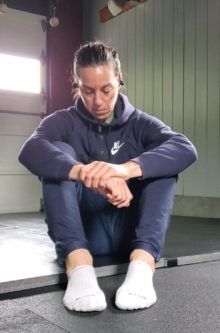There are three hinges on the feature photo door. It’s a strong front door, solid and meant to take some battering. The cheaper, lighter, all-have-problems-closing-and-opening doors inside the house have only two hinges. Weight-load divided by two, or weight-load divided… Read more ›
Torsion. We all have it: a particular line of twist running through our carriage, gripping us in a certain way and keeping us upright. Each fold and joint tells its story, whether you realize it or not. It’s how we… Read more ›
This feature photo shows an unstaged photo of the top drawer of my filing cabinet in my locker room office. Note the bounty of certain items (that aren’t snacks). Shorts, pads, some extra underwear — all tell tale signs… Read more ›
This post serves as a follow up to: A Path Towards Harm. Otherwise titled: The things I did wrong when I didn’t pay attention or have compassionate patience. The tag to this blog used to read, “fix yourself.” But… Read more ›
A year ago, I published ‘Dead Ribs‘, documenting the neglect of my ribcage in favor of my pelvis. Other than examining lateral movement, the breakthrough there was that to open the ribs I could lengthen through the front rather than… Read more ›
Paying attention brings awareness that paves the way for learning. While the task of directing attention typically goes to teachers, the chore of controlling attention falls on the student. We are bored by things that don’t seem to apply to… Read more ›
This hurts. The most common reaction is to stop using it or doing that. It’s even the advice of many medical professionals. Rest, it is assumed, is a cure all. But what happens when this magic pill doesn’t work? When… Read more ›
This is another concept coming from the astute observations of Nicole Uno. The medical, fitness, and wellness worlds are fixated on correcting imbalances. Amidst all the readily available treatment plans, too few remain curious about why so many asymmetries… Read more ›
Thematic teaching offers an umbrella students can return to to make their own connections. It provides a constant amidst the chaos to formulate conclusions and test variables against. Stepping back and trying to see the bigger picture of my classes,… Read more ›
Slings. I’ve heard them referred to often, but never quite knew what they were or why they were important. I understood that they were anatomically determined lines within the body, but in a structure that is fully connected, it didn’t… Read more ›
The following is part one of my course notes and findings from Stress, Movement, and Pain. Linked through the perception of threat and cause to protect, Seth Oberst generously delivered on the hows, whats, and whys between sensation (or lack… Read more ›
For a long time, I believed that extension was the working opposite of flexion. They felt as contrary as they looked. Folding forward was natural and effortless. Folding back was a resistance to that ease. The struggle was a lesson… Read more ›
When assessing the lower leg, it has become common place to examine the foot. The pliable and separable toes receive much of the attention. The heel, strange and seemingly uninteresting, gets neglected. Considering the calcaneous is a starting point… Read more ›
Doing without knowing. Playing, creating, learning. Adjusting and adapting. Describing Fighting Monkey is an act in organizing verbs. Everything overlaps and intertwines and is a wonder. The only certainty you are left with is that you have experienced something good… Read more ›
Ah, gravity. The beautiful constant. 9.8 meters per second (squared) you can rely on again and again to hold you down. Many times we see it as our enemy, a hindrance to our speed and power. But in the world… Read more ›


















